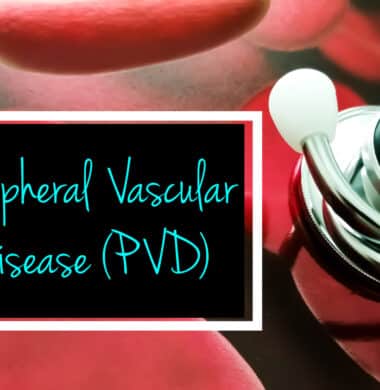Common Treatments for Peripheral Vascular Disease

Peripheral vascular disease (PVD) describes a condition in which the blood vessels in your arms and legs become constricted or even blocked. This is usually due to atherosclerosis, the buildup of fatty deposits in your blood vessels. It includes both peripheral arterial disease (PAD) and peripheral venous disease (also sometimes abbreviated PVD – we will spell this out when we need to make the distinction). PVD limits the blood flow to and from these parts of your body, which can cause pain, reduce function, damage the affected areas, and increase your risk of deadly complications like pulmonary embolism (PE) and stroke.
Fortunately, though, cardiology has numerous treatments for PVD, including lifestyle changes, medications, and procedural interventions.
Lifestyle Treatments
One of the most important things to understand about PVD is that it rarely happens in isolation. It’s often associated with other health problems in general and cardiovascular problems in specific. As a result, many of the lifestyle recommendations a cardiologist will recommend to treat PVD will be familiar to you.
To treat PVD, your cardiologist might recommend that you:
- Quit smoking: Smoking is terrible for your heart, your lungs, and the rest of your cardiovascular system, including your peripheral veins and arteries. Smoking is the primary risk factor for PVD, and quitting smoking can significantly reduce your risks.
- Eat a healthy diet: Healthy eating is also critical to keeping your cardiovascular system healthy. A healthy diet emphasizes vegetables, fruits, and whole grains while limiting saturated fat, sodium, sugar, and alcohol.
- Get active: Regular physical activity keeps your heart healthy, and it also helps your body maintain healthy peripheral veins and arteries. If you have lived a relatively inactive lifestyle to this point, talk to your doctor before starting an exercise program and consider supervised exercise at first.
- Achieve a healthy weight: Losing weight is always harder than you might expect. However, it’s worth it as your risk of PVD and many related health conditions increases if you are overweight. Even if you don’t achieve your goal weight, any amount of weight loss can reduce your risk of PVD and other conditions.
- Manage stress: Stress can make it harder for you to live a healthy lifestyle. People often eat when stressed. Smokers find it harder to quit if they are stressed, and stress can keep you from exercising.
Lifestyle treatment for PVD is typically used when your condition is not serious or in combination with other treatments. If you are diagnosed with PVD, don’t assume that lifestyle changes are enough to treat the condition.
Medications

- Anti-clotting medications: One of the dangers of PVD is that blood clots will form. These blood clots can completely obstruct the peripheral veins or arteries, cutting off vital blood flow. Other times, the blood clots might travel to the heart, lungs, or brain, leading to a coronary embolism, pulmonary embolism, or stroke. Antiplatelet medications like clopidogrel or cilostazol can help reduce the risk of blood clots. Anticoagulants like heparin or warfarin use a different mechanism to stop your body from forming clots.
- Statins: These very common medications work to lower cholesterol and fats in the blood, slowing the buildup of deposits in the blood vessels.
- Blood pressure medications: Some medications intended to lower your blood pressure can also combat constriction of blood vessels. For example, ACE inhibitors combat your body’s production of a chemical that tightens and narrows the blood vessels. This helps your blood vessels relax, improving the flow of blood.
Medications can be used at any stage of PVD. Cardiologists sometimes recommend them as a standalone approach, but they are more often combined with other treatments.
Procedures and Surgery
If you have advanced PVD, you might benefit from direct interventions to facilitate blood flow in the affected areas. These may include:
- Angioplasty: This is the most common procedure for blood vessels impacted by atherosclerosis. In this procedure, a deflated balloon is threaded through the blood vessels using a guidewire. When the balloon reaches the area of the constriction, a doctor will inflate it, squishing the plaque and expanding the blood vessel again. Angioplasty can include a stent – an expandable mesh tube that helps hold a blood vessel open after the procedure.
- Bypass surgery: Bypass surgery is reserved for the most severe cases of PVD. A surgeon will employ blood vessels taken from another part of your body or an artificial tube to give your blood another way to flow around the constricted blood vessel.
These procedures can provide significant improvement to your PVD. However, your cardiologist will usually recommend lifestyle changes and medications to maintain and build on the progress of an angioplasty or bypass.
Get an Effective Combination of Treatments for PVD
If you have been diagnosed with or suspect you might have peripheral vascular disease, South Denver Cardiology can help. We take a combined treatment approach to ensure each of our patients gets the treatment that is suited to their condition, risks, and abilities.
We offer some of the most advanced cardiovascular treatments in the area, but we are also proud of our ability to help patients through the least invasive approaches. Of course, we understand that making lifestyle changes is often easier said than done. That’s why we offer extensive support for healthy living with our on-site gym, nutritional education, and even massage therapy to help combat stress.
If you have been diagnosed with PVD and are looking for an effective, comprehensive approach to treatment, contact South Denver Cardiology for an appointment at our main office in Littleton or one of our satellite offices across the southern Denver suburbs.
- 6 Tips for Exercising Outdoors with a Heart Condition - May 19, 2025
- Lifestyle Changes That Can Help Manage Arrhythmia - April 30, 2025
- Common Treatments for Peripheral Vascular Disease - April 23, 2025
Sign Up
As with any health concerns, your specific treatment program should be discussed thoroughly with your primary care physician as well as any specialists who may need to be consulted – like a cardiologist.
Sign Up
